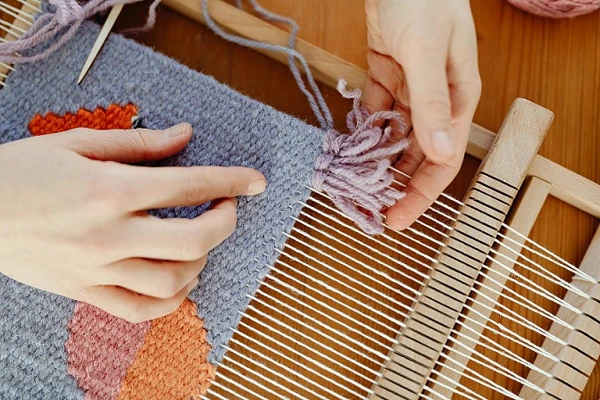Discover how to start weaving with looms today! Explore creating exclusive, personalized pieces for your home or as gifts.
Discovering the World of Looms
Looms are traditional and versatile tools used to interlace threads and create various fabrics. As a result, they allow you to transform threads into fabrics for exclusive pieces, ranging from rugs to wall hangings. Not to mention scarves for tying around your neck or cozy scarves for warmth in winter.
Additionally, with the versatility of the loom, you can create unique pieces with diverse designs. You can experiment with patterns and color blends using colorful polyester threads for projects like bags and totes. Similarly, using cotton threads, you can create functional pieces like trivets or coasters. It’s worth highlighting book markers, which, using threads and ribbons, are small projects that don’t require much time.
Looms provide different creative options, making them an opportunity for those seeking an alternative simple hobby.
Tips for Working with Different Types of Looms
For beginners, the hand loom model is compact and portable, making it ideal for practicing basic techniques and developing skills. What’s more, once you’ve learned the basics, you can create decorative tapestries and simple accessories with this tool. You can then evolve to a table loom, which offers more stability. With this, you can work on slightly larger projects, such as cushions and scarves.
Another option is the weighted loom, used especially for old techniques to stretch thicker threads for rug weaving. On the other hand, the spinning loom is used to transform fibers into threads like wool and cotton for weaving projects. The floor loom provides more stability and scale for large projects such as blankets, curtains, or large tapestries.
For more dynamic projects, the flying shuttle weaving loom makes the work easier due to its automation. Indeed, these are for larger projects, such as fabrics for clothing or décor. Before anything else, it is essential to understand the characteristics of each loom to determine which is more practical for your goal.
Weaving Material Tips
To start, consider materials like threads of different textures and colors that match your project. If you wish to use a linen loom, opt for natural fibers to create table runners or eco-friendly bags. However, for modern designs, mixed threads can be the combination for strength and flexibility.
Additionally, choosing the right threads makes a difference for the final project. Initially, wool threads are practical for tapestries or thick pieces. On the other hand, if you want to create pieces with light fabrics, opt for the versatility of cotton. But for a soft fabric with an additional shine, use silk.
Weaving requires some basic auxiliary materials depending on the type of project, thread, and loom used. For example, the comb is used to compress the weft threads, ensuring uniformity in the fabric. Next, large weaving needles help create patterns and details in the fabric. There are also scissors, clips, diagrams, and alignment tools.
Tips for Personalizing Your Loom Journey
To conclude, these are basic items to personalize as you go along, depending on your project type or experience level. One tip: there are ready-made weaving kits on the market that can be a good choice. Moreover, start with simple hobby designs, and as you gain confidence, try more elaborate techniques.
Curious to learn more? Check out other articles on the Feel the Beauty blog and get inspired for other simple hobby ideas!
- Is Travel a Hobby? Discover Its Relaxing and Enriching Side
- Best Outdoor Hobby: 24 Hobbies to Try This Year
- Hobbies for Ladies: A Fun Break from the Daily Routine
- Hobby for Women: Unique Activities to Explore New Interests
- Hydro Indoor Garden: Your Green Hobby, Your Way












